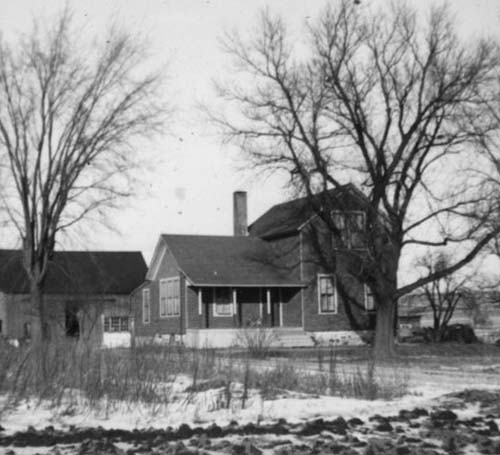
“Twin Elm Farm”, from a set of rural Wisconsin photos taken around 1938.
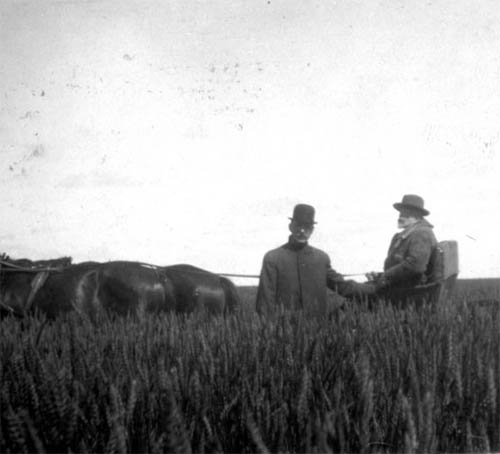
Two men, one in a buggy, one standing. From a photo postcard, dated 23 February 1912.
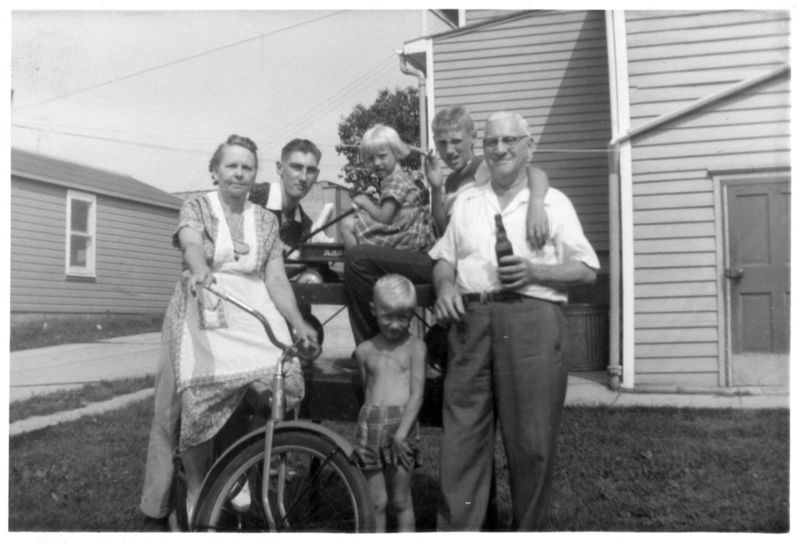
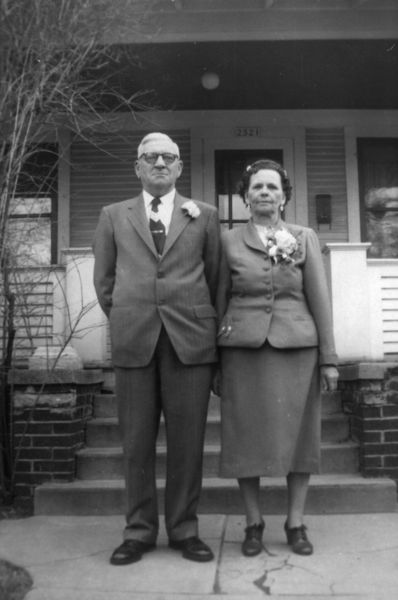
From a photo album originating in Wisconsin, 1950s presumably. (more here)
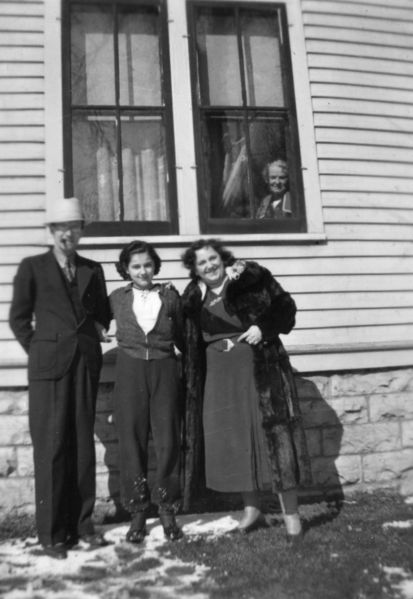
“Three Musgaters” (sic, I believe “Musketeer” was their intent), late 1930s. Scanned from photograph. (more here)
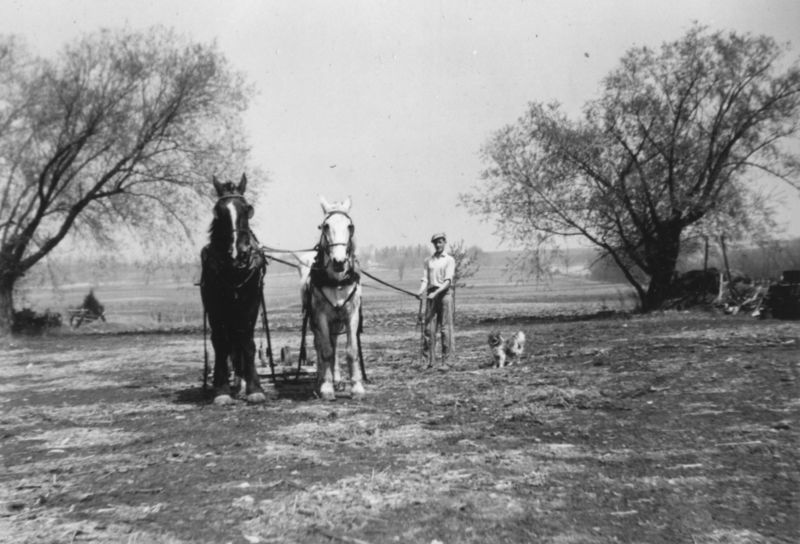 This photo was titled, “Bob, Flipo, and Elmer.” However, we’ve got four entities in the photo: Two horses, a man, and a dog. So, who’s who? Elsewhere in the album, we’ve met an “Elm“, which is probably short for Elmer, and a Brownie, that looks a bit like this dog. So, that means the horses are named “Bob” and “Flipo.” What are Bob and Flipo doing? It looks like they’re hitched to a drag of some sort, scraping the surface of the ground to turn the turf under and either prepare it for planting, or just turn the weeds under so they don’t become too unmanageable.
This photo was titled, “Bob, Flipo, and Elmer.” However, we’ve got four entities in the photo: Two horses, a man, and a dog. So, who’s who? Elsewhere in the album, we’ve met an “Elm“, which is probably short for Elmer, and a Brownie, that looks a bit like this dog. So, that means the horses are named “Bob” and “Flipo.” What are Bob and Flipo doing? It looks like they’re hitched to a drag of some sort, scraping the surface of the ground to turn the turf under and either prepare it for planting, or just turn the weeds under so they don’t become too unmanageable.
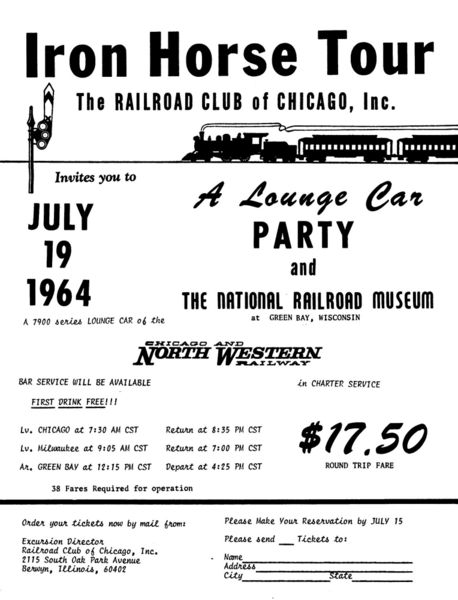 On July 19, 1964, a group of railroad aficionados piled aboard a 7900 series lounge car belonging to the Chicago and North Western Railway, en route to the National Railroad Museum in Green Bay, Wisconsin. The Railroad Club of Chicago sponsored this ‘lounge car party,’ bringing along friends from Milwaukee along the way, and providing one free drink in the fare. I imagine that a car-full of railroad guys — at least 38 of them — in a moving bar for five hours straight were a mighty friendly bunch when they disembarked in Green Bay. I’m pleased to see that the club is still around. Too often, ‘archaic’ clubs like these dwindle in numbers as their members age and fall away, but railroad people are an odd bunch; the romance of the rails meets men’s natural affinity for huge, loud, mechanical machines, and you end up with some fun-loving guys who’ll pile on a train and road-trip to Green Bay to see more trains. Today, they promote rail travel, discuss community history revolving around trains, and remind everyone that, even though trains are disappearing, they meant a lot to the United States we live in.
On July 19, 1964, a group of railroad aficionados piled aboard a 7900 series lounge car belonging to the Chicago and North Western Railway, en route to the National Railroad Museum in Green Bay, Wisconsin. The Railroad Club of Chicago sponsored this ‘lounge car party,’ bringing along friends from Milwaukee along the way, and providing one free drink in the fare. I imagine that a car-full of railroad guys — at least 38 of them — in a moving bar for five hours straight were a mighty friendly bunch when they disembarked in Green Bay. I’m pleased to see that the club is still around. Too often, ‘archaic’ clubs like these dwindle in numbers as their members age and fall away, but railroad people are an odd bunch; the romance of the rails meets men’s natural affinity for huge, loud, mechanical machines, and you end up with some fun-loving guys who’ll pile on a train and road-trip to Green Bay to see more trains. Today, they promote rail travel, discuss community history revolving around trains, and remind everyone that, even though trains are disappearing, they meant a lot to the United States we live in.
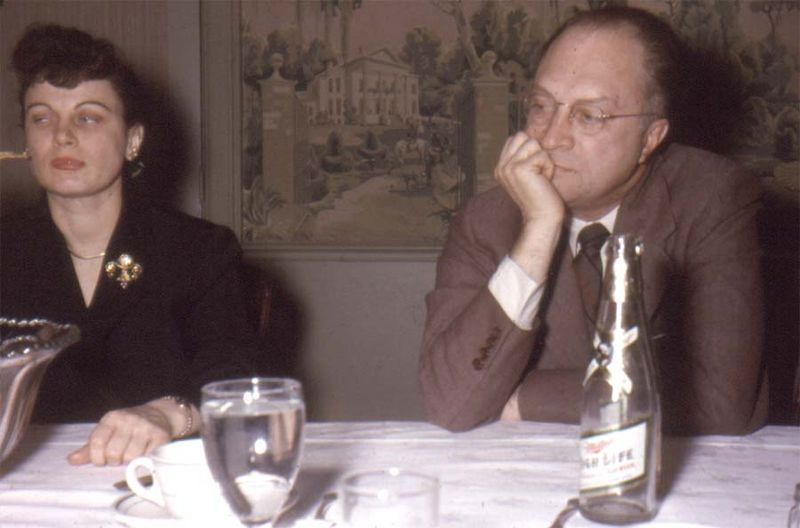 You may think Wednesday’s crack about Grandma getting tipsy off a couple ounces of Miller High-Life was a joke, the photo above shows that the Cool Kids drank High Life. This is clear proof is from the Pfister Hotel set, but the distinctive trapezoid label with an ‘X’ sticker right above it makes the bottle very recognizable even in small photos from other sources. Granted, these photos are from Wisconsin — Milwaukee is the home of Miller Brewing, and until the 70s there wasn’t as much national distribution as there is today. People tended to drink the beer that was brewed nearby, partly out of sentimental reasons, but also because you knew the beer was fresh. Your parents probably have stories about driving to another state to buy some good beer — driving from North Dakota to Colorado to buy up a pickup-truckload of Coors has been told to be by more than one person. One poster at Beer Advocate tells of driving to Wisconsin for some High Life…but more because of the lower drinking age of 18. As for the sentimental reasons, High Life had already been around for fifty years by the time this photo was taken — it was “the champagne of beers”, for crying out loud. Regardless if the stuff tasted like crap, you didn’t dare buy something else when company was coming over, and being caught at a swanky hotel lounge drinking anything else would be a travesty.
You may think Wednesday’s crack about Grandma getting tipsy off a couple ounces of Miller High-Life was a joke, the photo above shows that the Cool Kids drank High Life. This is clear proof is from the Pfister Hotel set, but the distinctive trapezoid label with an ‘X’ sticker right above it makes the bottle very recognizable even in small photos from other sources. Granted, these photos are from Wisconsin — Milwaukee is the home of Miller Brewing, and until the 70s there wasn’t as much national distribution as there is today. People tended to drink the beer that was brewed nearby, partly out of sentimental reasons, but also because you knew the beer was fresh. Your parents probably have stories about driving to another state to buy some good beer — driving from North Dakota to Colorado to buy up a pickup-truckload of Coors has been told to be by more than one person. One poster at Beer Advocate tells of driving to Wisconsin for some High Life…but more because of the lower drinking age of 18. As for the sentimental reasons, High Life had already been around for fifty years by the time this photo was taken — it was “the champagne of beers”, for crying out loud. Regardless if the stuff tasted like crap, you didn’t dare buy something else when company was coming over, and being caught at a swanky hotel lounge drinking anything else would be a travesty.
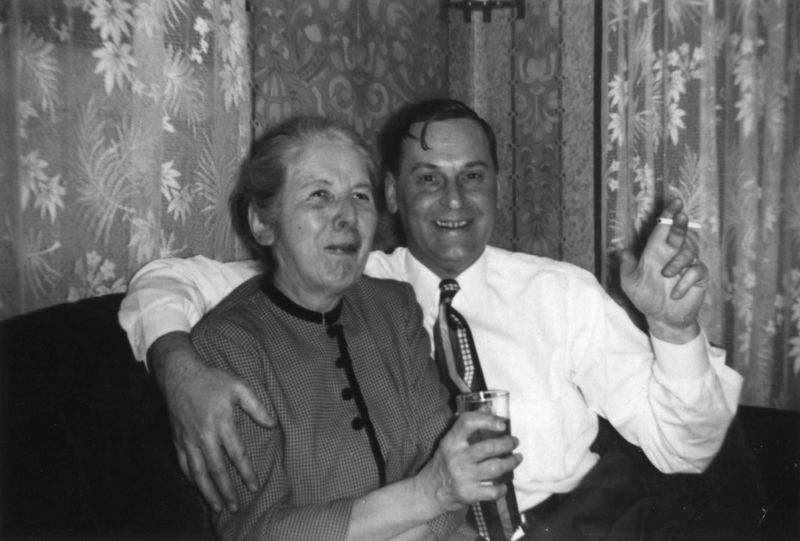 Give Grandma a jelly-jar glass of Miller High-Life, and she might start to get a bit tipsy, don’t you know. Sometime in the 50s in Wisconsin, there was a party — I’ve got more pictures to upload — that prove there’s a big gap in what partying means today. In the 21st century, partying is what kids do. People get wasted on their 21st birthday, get their first job and drink every Friday and Saturday in bars with loud, untalented rock bands screaming into microphones, and sleep the bender off every Sunday. By the time they’re thirty, those childish ways are behind them and partying now means a $12 martini with a $20 steak and a jazz trio in the corner. The fifties were less age-centric in their parties: Kids did their partying when they had the money and time to do so, but grown-ups didn’t see getting plastered as a childish activity. If you’re in your thirties, ask your parents for stories about your grandparents: unless they were teetotalers, they probably had raucous parties…which, for the time period, meant listening to mildly naughty comedy records, playing cards, air so smoky it turned blue, drinking so much that someone had to be carried home, and driving all over town without fear of being stopped by the cops unless you actually hit something (then sitting bleary-eyed through church the next day). No wet t-shirt contests, no noise ordinance violations, no stepping over people sleeping on the floor at 11am who were too drunk to drive, no vomit on the front porch — fifty years makes all the difference.
Give Grandma a jelly-jar glass of Miller High-Life, and she might start to get a bit tipsy, don’t you know. Sometime in the 50s in Wisconsin, there was a party — I’ve got more pictures to upload — that prove there’s a big gap in what partying means today. In the 21st century, partying is what kids do. People get wasted on their 21st birthday, get their first job and drink every Friday and Saturday in bars with loud, untalented rock bands screaming into microphones, and sleep the bender off every Sunday. By the time they’re thirty, those childish ways are behind them and partying now means a $12 martini with a $20 steak and a jazz trio in the corner. The fifties were less age-centric in their parties: Kids did their partying when they had the money and time to do so, but grown-ups didn’t see getting plastered as a childish activity. If you’re in your thirties, ask your parents for stories about your grandparents: unless they were teetotalers, they probably had raucous parties…which, for the time period, meant listening to mildly naughty comedy records, playing cards, air so smoky it turned blue, drinking so much that someone had to be carried home, and driving all over town without fear of being stopped by the cops unless you actually hit something (then sitting bleary-eyed through church the next day). No wet t-shirt contests, no noise ordinance violations, no stepping over people sleeping on the floor at 11am who were too drunk to drive, no vomit on the front porch — fifty years makes all the difference.
Especially the wallpaper and drapes. The modernism of the sixties and seventies have ruined our decor. In the fifties, you could install flocked wallpaper without any sort of irony. Today, we might think that they had to be drunk to buy that wallpaper back then…they probably were, but it had nothing to do with the decor.
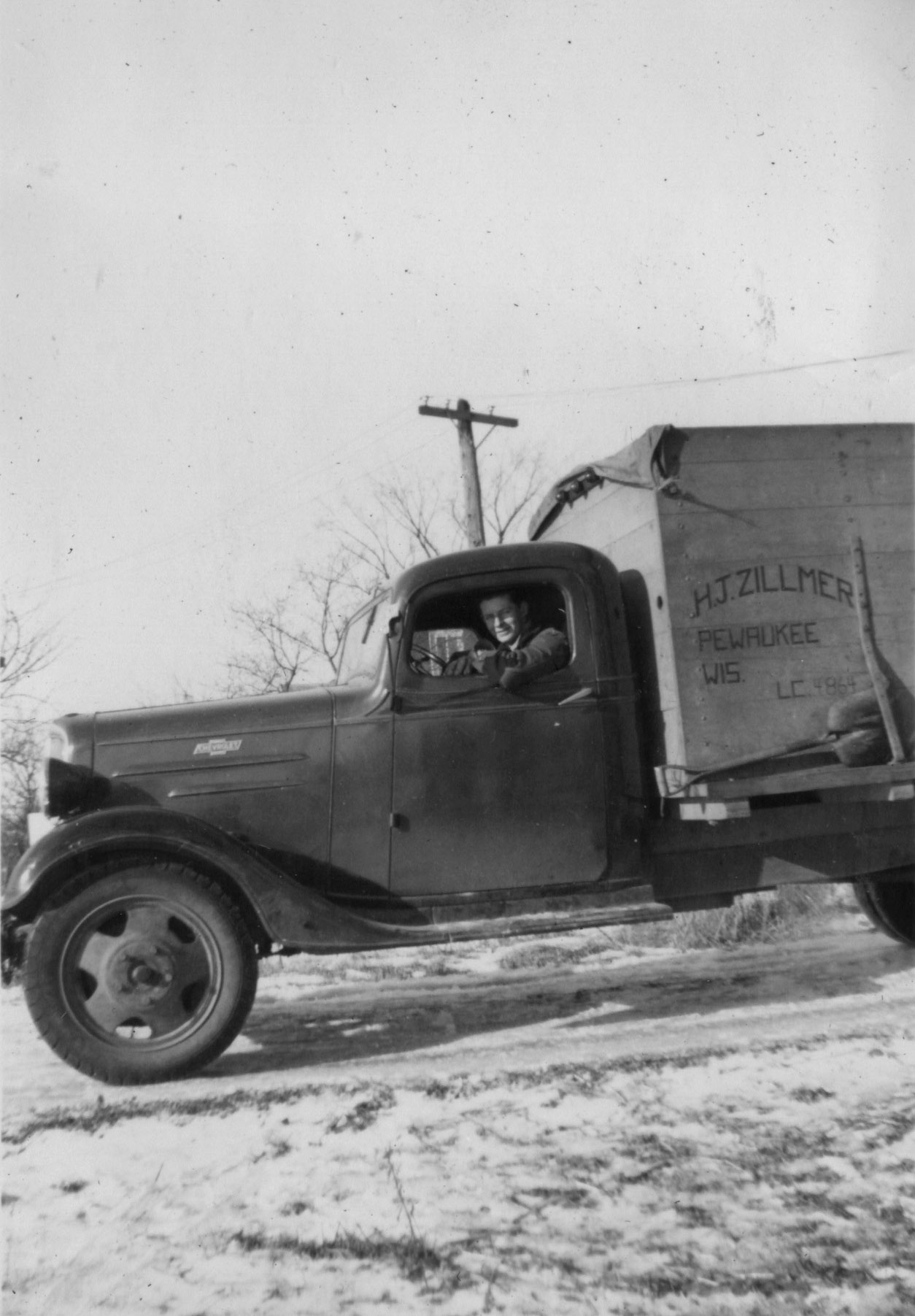 This picture was captioned “Howie.” Mr. Zillmer had a truck, was from Pewaukee, Wisconsin, owned a 1930s-era Chevrolet truck, and was friends with the photographer of this album. That’s about all we know — and with this magic of the internet, can anything more be discovered? Not as much as you might think — Howie could certainly be “Howard Zillmer” — the internet brings us a flyer from a church in Florida that lists Zillmer’s birthday as January third — Florida’s quite a ways away from Wisconsin, though. 2003 brought us the obituary of a Howard Zillmer’s mother, Augusta, who had been born in 1910 and lived in Pewaukee. Howard E Zillmer enlisted in the military in Milwaukee shortly after World War II broke out, but — also in Milwaukee — Howard R Zillmer held out until ’43. Our photogenic Howard, however, looks older than any of the possible Howards on the internet. If internet archives have slowly reached back to the ’40s, maybe eventually we’ll be able to find Howie. Until then, he’s remembered for driving his grain truck past Ruth.
This picture was captioned “Howie.” Mr. Zillmer had a truck, was from Pewaukee, Wisconsin, owned a 1930s-era Chevrolet truck, and was friends with the photographer of this album. That’s about all we know — and with this magic of the internet, can anything more be discovered? Not as much as you might think — Howie could certainly be “Howard Zillmer” — the internet brings us a flyer from a church in Florida that lists Zillmer’s birthday as January third — Florida’s quite a ways away from Wisconsin, though. 2003 brought us the obituary of a Howard Zillmer’s mother, Augusta, who had been born in 1910 and lived in Pewaukee. Howard E Zillmer enlisted in the military in Milwaukee shortly after World War II broke out, but — also in Milwaukee — Howard R Zillmer held out until ’43. Our photogenic Howard, however, looks older than any of the possible Howards on the internet. If internet archives have slowly reached back to the ’40s, maybe eventually we’ll be able to find Howie. Until then, he’s remembered for driving his grain truck past Ruth.